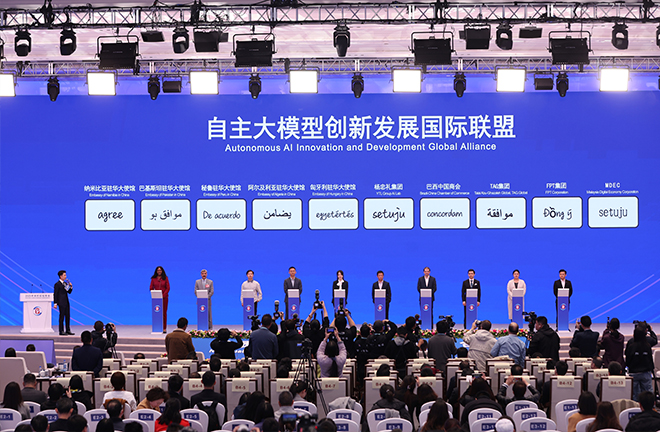Advancing science and technology decision-making toward an intelligent paradigm

The signing ceremony for the Autonomous AI Innovation and Development Global Alliance took place during the 2025 Zhongguancun Forum Annual Conference, held in Beijing from March 27 to 31. Photo: IC PHOTO
Science and technology (S&T) decision-making refers broadly to decisions surrounding the development, promotion, application, management, and regulation of science and technology. Emerging technologies such as big data, AI, the Internet of Things, and cloud computing are now assisting—and in some cases replacing—humans in an ever-growing range of decision-making tasks. In this context, S&T decision-making must evolve toward an intelligent decision-making paradigm.
Decision-making became scientific
Before the rise of modern science and technology, decision-making relied heavily on individual experience. Prior to the widespread adoption of computer technology, many government agencies established decision-support information systems. However, the lack of advanced data storage, transmission, and processing technologies meant that information available to decision-makers was often outdated. Moreover, under hierarchical bureaucratic structures, information had to pass through multiple layers, increasing the likelihood of distortion by “gatekeepers.” These limitations made timely and scientifically grounded decision-making difficult to achieve.
In the 1960s, computer technology enabled the introduction of management information systems and expert systems. In the 1970s, decision support systems emerged by integrating human intelligence with computing capabilities. By the 1990s, decision system theories were combined with new technologies such as online analytical processing and data mining, enabling functions such as data cleansing, restructuring, and the transformation of multidimensional data into actionable decision-support information.
In the 21st century, with the convergence of technologies such as the internet, multimedia, grid computing, and knowledge management, a new generation of collaborative decision support systems has emerged. Since 2008, the rise of big data has further enhanced decision-making capabilities by enabling real-time data stream analysis, predictive modeling, and more accurate interpretation of complex phenomena—addressing many of the shortcomings of experience-based decision-making. In 2022, the release of ChatGPT catalyzed the use of generative AI in decision-making, leading to the development of intelligent decision-making systems.
Toward intelligent decision-making
Intelligent decision-making exhibits three key characteristics: the ability to make automated decisions under specified conditions; a capacity for full-process decision response; and the prediction of future trends accompanied by tailored solutions.
The effectiveness of intelligent decision-making systems depends on two factors. The first is a system’s inherent decision-making capability, determined by the quality of its data, algorithms, and computing infrastructure. Ideally, the data involved should be comprehensive, real-time, and objective. Algorithms must be capable of transforming varied structured data into computable and inferential knowledge, executing a wide array of natural language tasks, and identifying new patterns or emergent features. The computing infrastructure must offer high-speed processing, efficient network transmission, and ample storage capacity.
The second factor is the quality of human-machine interaction between decision-makers and intelligent decision-making systems. While these systems hold clear advantages over humans in speed, endurance, emotional neutrality, and multitasking, they have yet to surpass humans in perception, creativity, agency, and morality. A collaborative model that combines the strengths of both human and machine to maximize complementary advantages is thus essential.
The future development of intelligent decision-making is likely to exhibit several trends.
First, intelligent systems driven by big data are expected to gradually replace experience-based approaches. Second, advances in technology and infrastructure will lead to more customized, scenario-specific applications. Third, decision-making systems will become more platform-based, involving an increasingly diverse range of participants. Fourth, while intelligent systems will not fully replace decision-makers or think tank experts, their roles will evolve: decision-makers must evaluate and refine system-generated outcomes, while experts must translate accumulated decision-making experience into algorithmic models.
Technological progress is reshaping decision-making paradigms, and S&T decision making must embrace this shift. First, the development and application of intelligent decision-making technologies should be integrated into national strategies. Second, research into foundational theories and original algorithms should be deepened. Third, infrastructure underpinning intelligent decision-making systems should be strengthened through the creation of dedicated data platforms, open-source algorithm libraries, and a national public computing resource platform. Fourth, application scenarios should be cultivated based on the needs of decision-making bodies and end users. Finally, talent development is critical: both decision-makers and technical professionals must be equipped with the skills to navigate and advance intelligent decision-making systems.
Liu Haibo is a research fellow from the Institutes of Science and Development at Chinese Academy of Sciences. Xia Ziye is from the Institute for Social Governance and Development at Tsinghua University.
Edited by WANG YOURAN

 PRINT
PRINT CLOSE
CLOSE